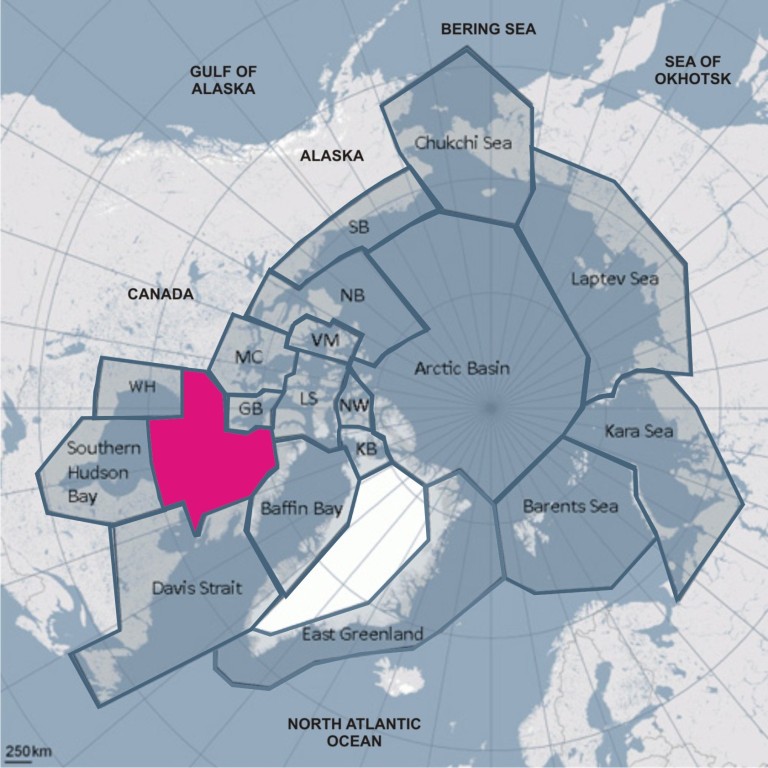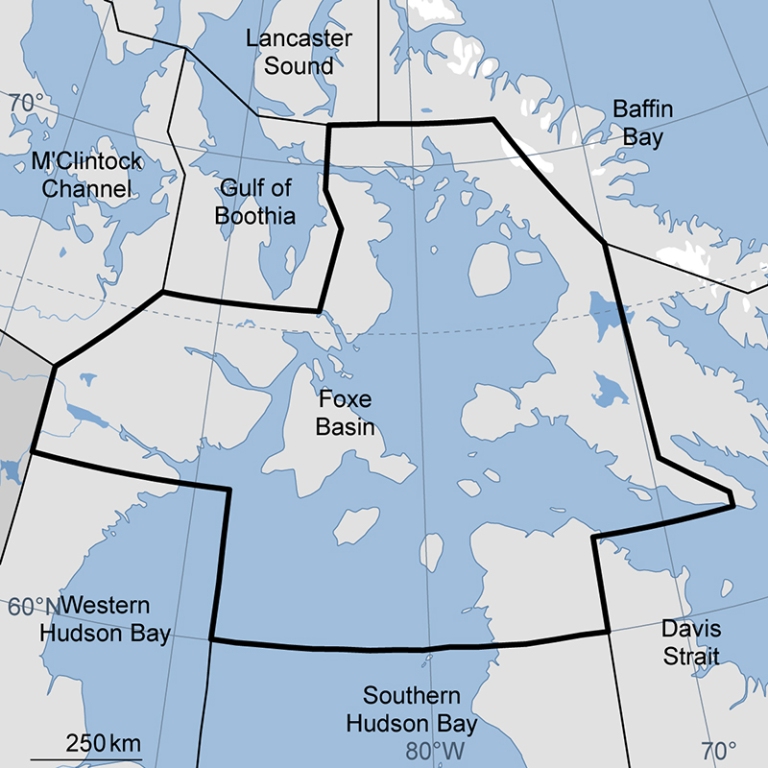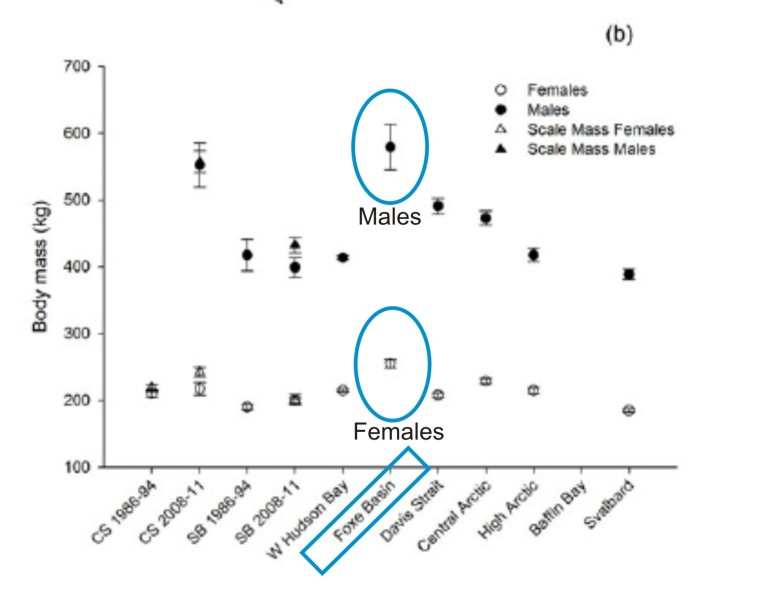Foxe Basin polar bear status – another stable population.

Figure 1. Polar bear subpopulation regions defined by the Polar Bear Specialist Group, Foxe Basin marked.
Foxe Basin is a large subpopulation region (Fig. 1), with a total area of 1.18 million square km (Vongraven and Peacock 2011). It comprises Northern Hudson Bay and western Hudson Strait, and the area between western Baffin Island and eastern Melville Peninsula, with a large island (Southampton Island) in the middle (Figs. 2 and 3).

Figure 1. Foxe Basin polar bears subpopulation region, courtesy IUCN PBSG
The last IUCN Polar Bear Specialist Group (PBSG) report (Obbard et al. 2010: Table 1, pdf of “updated” online version here) assigned the Foxe Basin subpopulation an estimate of 2,197 bears (1,677-2,717).
At that time, Foxe Basin was considered “data deficient” as to its current status, current trend and future (next 10 years) trend. That estimate was based on a mark-recapture survey conducted in 1994 (Taylor et al. 2006), but was adjusted in 2004 to 2,300 bears (1,780-2,820) to reflect increases noted by local Nunavut residents.
The most recent population data comes from an aerial survey of Foxe Basin in 2009/2010, which generated an estimate of ~2,580 bears, slightly above the early 1990s estimate of ~2,300 (Stapleton et al. 2012). While the two methods (aerial survey and mark-recapture) are not directly comparable, the aerial survey does suggest the population has not declined. It is now considered stable.
Here’s a comparison of all the subpopulations that had 2,000 bears or more at last count (Obbard et al. 2010; Stapleton et al. 2012), with their most recent estimate, range and date of the estimate, plus the approximate area in square kilometers (according to Vongraven and Peacock 2011):
Barents Sea 2,650 (1,900-3,600:2004), area ~1.69 million km2
Foxe Basin 2,580 (2,100-3,200:2010), area ~1.18 million km2
Lancaster Sound 2,541 (1,759-3,323:1998), area ~0.49 million km2
Davis Strait 2,142 (1,811-2,534:2007), area ~2.62 million km2
Baffin Bay 2,074 (1,544-2,604:1998), area ~ 1.08 million km2
The text summary for Foxe Basin in the 2009 PBSG report (Obbard et al. 2010:45-46) has this to say:
“During the ice-free season, polar bears are concentrated on Southampton Island (the number of bears on the island was estimated at 240 independent bears in August 2008; S. Stapleton, unpublished data, Peacock et al. 2008) and along the Wager Bay coast; however, significant numbers of bears are also encountered on the islands and coastal regions throughout the Foxe Basin area (Peacock et al. 2008; see Research in Canada, this volume).
A total subpopulation estimate of 2,119 ± 349 was developed in 1996 (Taylor et al. 2006c) from a mark-recapture analysis based on tetracycline biomarkers. The marking effort was conducted during the ice-free season, and distributed throughout the entire area.
TEK [Traditional Ecological Knowledge] suggests the subpopulation of polar bears has increased (GN consultations in villages in Foxe Basin 2004-2009); the subpopulation estimate was increased to 2,300 bears in 2005.”

Figure 3. Northern Foxe Basin region details, from Environment Canada.
One of the results that came out of recent Chukchi Sea polar bear research (see here and here), was that Foxe Basin bears (both males and females) were the only ones in better condition than Chukchi Sea (CS) bears (Fig. 4).

Figure 4. Weight of Foxe Basin male and female polar bears (circled by me) compared to other populations measured. CS, Chukchi Sea; SB, Southern Beaufort; Central Arctic = parts of Gulf of Boothia and M’Clintock Channel; High Arctic = Lancaster Sound. This is figure 5b from Rode et al. 2014.
Some Foxe Basin males are known to successfully hunt walrus, which may explain in part their extraordinarily good condition. While it is doubtful if the killing of walrus is routine amongst males, many bears may feed off the carcasses taken by males that hunt successfully — including subadults, females with cubs and cubs on their own for the first time.
Thiemann and colleagues (2008) found that Foxe Basin bears they sampled ate the largest proportion of walrus (~7% of their total diet, highest amongst adult males). They also had a more varied diet than some other subpopulations, although ringed seals still made up the bulk of their diet (Fig. 5.). Variety may be the key, as some prey may be more abundant at certain times of the year.

A story published by NunatsiaqOnline (June 26, 2012), quoted from a Nunavut Government press release issued after the final report on the 2010 aerial survey was released:
“The estimated number of polar bears in the Foxe Basin is 2,580 animals, a number which the GN [Government of Nunavut ] said is comparable to the estimate from the early 1990s, “even though annual harvest rates have also remained stable over the past 20 years.”
“Inuit knowledge and scientific observations of polar bear body condition and litter sizes suggest that the subpopulation is healthy overall,” the GN said.
The aerial survey results did not provide evidence to suggest that climate change is “negatively influencing” polar bears in the Foxe Basin area.” [my bold]
I’ll have more to say about the controversy over setting harvest quotas in Foxe Basin and some rather astonishing comments that have arisen in the process. Stay tuned.
polarbearscience.com/2014/02/12/foxe-basin-polar-bear-status-another-stable-population/It looks like the male polar bears which successfully hunt walruses are these from Foxe Basin. These which cross paths with the barren ground grizzlies are smaller over average compared to the average yellowish white bear in Foxe Basin.